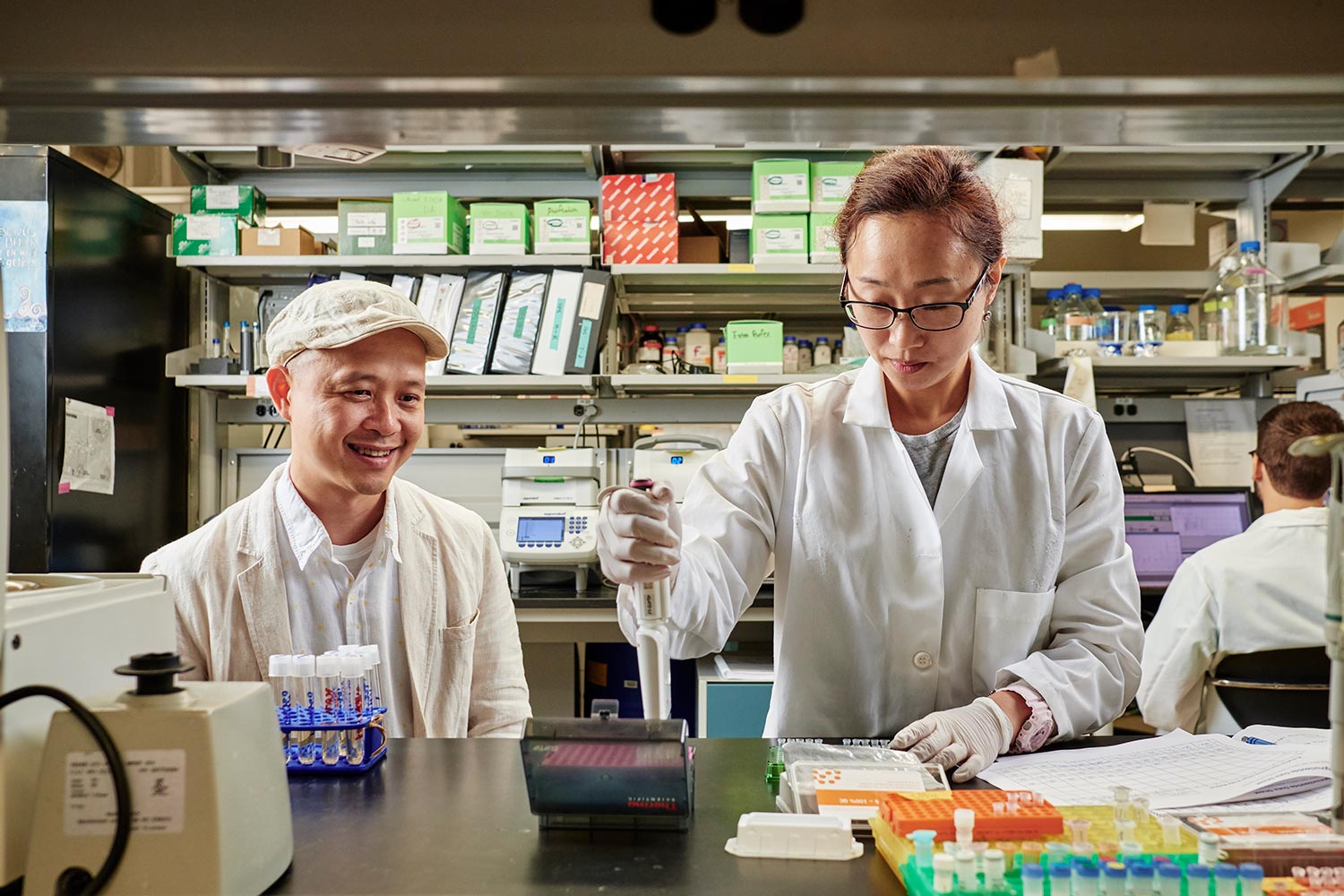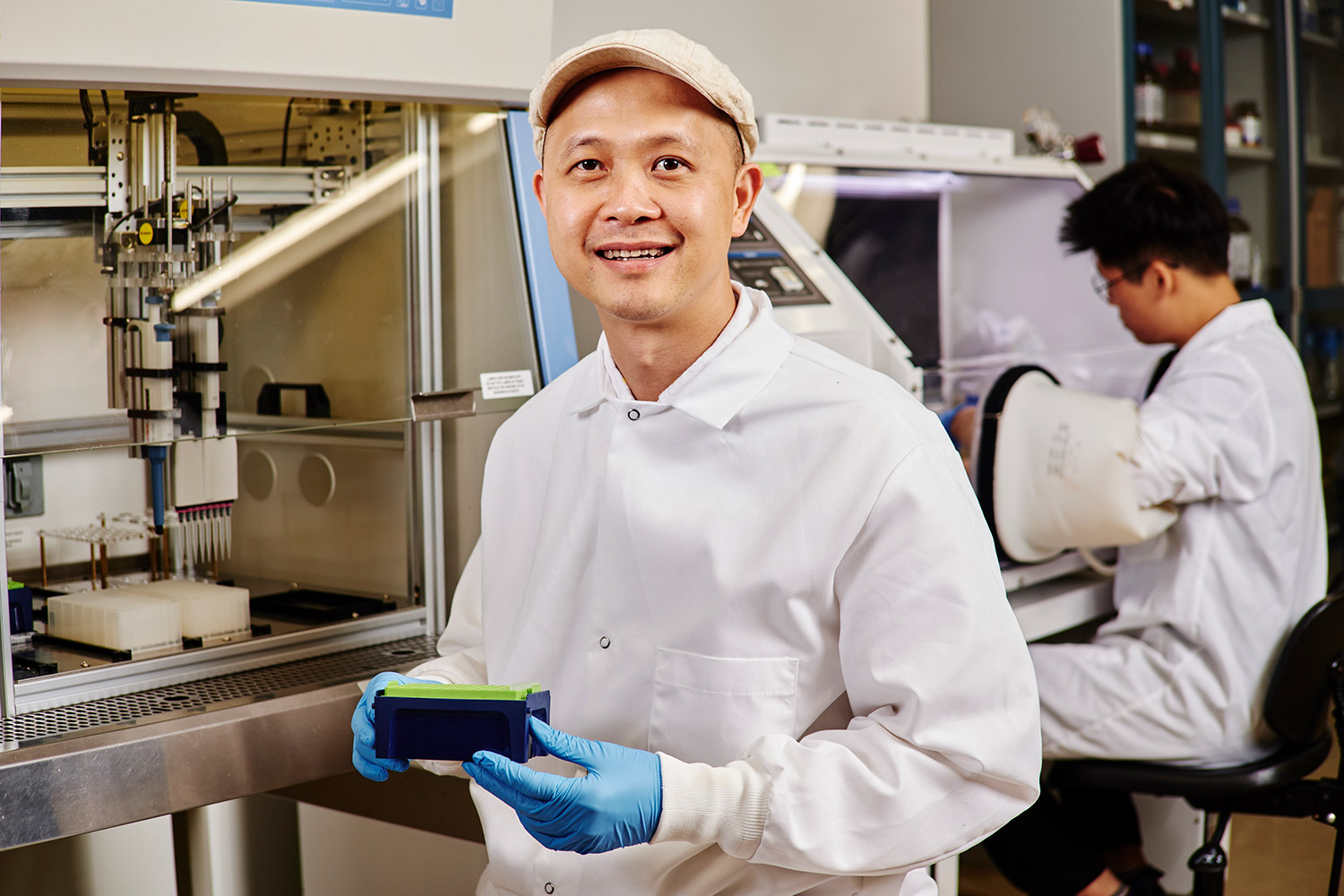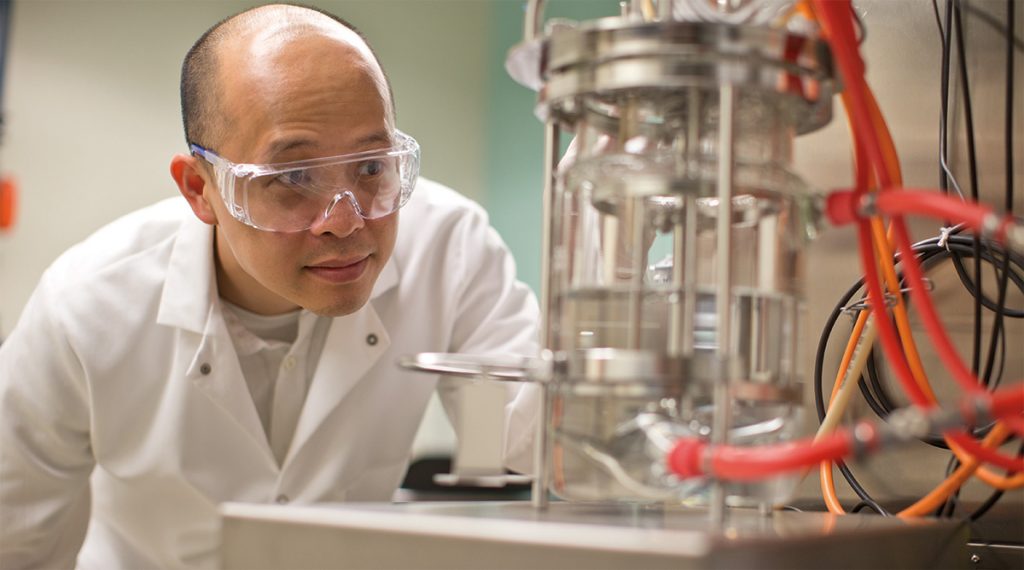Ferguson Faculty Fellow Cong Trinh believes that good things come in small packages—which is why he is developing microscopic assistants to help him achieve big things.
“Biological modularity exists at many scales in nature, from enzymes to metabolic pathways, to single cells, to microbial communities,” said Trinh, a professor in UT’s Department of Chemical and Biomolecular Engineering (CBE). “I am passionate about harnessing these modular systems and synthetic biology to solve the challenging health, energy, sustainability, and climate change problems we face today.”
Balancing Cell Processes
Trinh analyzes the metabolic processes within a cell to identify pathways that could make industrially useful products, like the esters in essential oils, and break down pollutants, like polyolefin plastics. He then uses a genome editing technique called CRISPR-Cas to introduce new, useful genes into the cell’s genome—and, often, to deactivate others.
“Cells have to invest resources into the metabolic pathways we tweak them to conduct,” Trinh said. “Resource allocation to a specialized task, like ester production, must be balanced with other cell processes or the cells will be overburdened and inefficient.”

For example, if Trinh induces a cell to produce more of a certain ester, he may deactivate metabolic pathways that use one of the ester’s precursors. That way, all the precursor molecules will become the desirable ester.
Revisiting Roots in Genomics
Much of the pioneering work applying CRISPR-Cas to genome editing was conducted at the University of California, Berkeley (UCB), where Trinh worked as a postdoctoral researcher before joining the UT faculty in 2011.
Last spring, Trinh returned to UCB for a sabbatical to advance his genome engineering skills and support his development of modular microbes and microbe consortia. He was hosted by bioengineering professor Adam Arkin, an expert in large-scale functional genomics.
“Dr. Arkin’s laboratory at UCB and the Lawrence Berkeley National Laboratory (LBNL) has a diverse, exciting research program,” Trinh said. “His research group is working on the broad areas of systems and synthetic biology, which are well aligned with my research interests.”
Arkin specializes in loss-of-function and gain-of-function screening, exposing modified microbes to one or multiple stressors and using high-throughput sequencing to understand which genes are turned on or off under various conditions.
Working with Arkin’s team helped Trinh explore innovative approaches to microbial metabolic engineering and continue his ongoing functional genome studies of Yarrowia lipolytica and Bacillus coagulans, microbial species he has been tweaking to break down plastics and turn wood into valuable esters, respectively.
“These techniques are documented in the scientific literature, but there are always tricks that you need to know to make them work,” Trinh said. “I was amazed by the depth and breadth of the problems that they are pursuing at UCB. This sabbatical helped me to synthesize new ideas. I anticipate that my research direction will be expanding rapidly in the years to come.”
Penning Publications
While exploring new research ideas, Trinh also had valuable time to complete and submit four peer-reviewed manuscripts for research projects supported by the US Department of Energy, the UT-Oak Ridge Innovation Institute, and the Center of Bioenergy Innovation at ORNL.

One publication details Trinh’s research delving into the use of CRISPR-Cas antimicrobial agents, which are promising for controlling the spread of both bacterial and fungal pathogens. With several collaborators from CBE, Trinh helped demonstrate that attacking essential function genes to control pathogenic microbes is much more effective when defensive DNA repair genes are also deleted—an innovative approach that enhances the lethality of the treatment while also mitigating the microbes’ ability to evolve resistance.
The other three projects involved the development of new microbes that produce highly desirable materials from lignocellulosic mass or plastic waste.
Staying Busy with Microbes
The first of these studies, which Trinh completed with CBE alum Hyeongmin Seo (PhD ’21) and collaborators at University of California, Riverside, resulted in a new strain of Clostridium thermocellum that cannot digest esters or create lactic acid, allowing it to efficiently produce desirable short-chain esters from poplar wood.
In the second microbe development study, conducted with Seo and UT CBE alum Gillian Castro (BS ’23), Trinh exploited consortia of cell specialists to make esters selectively. The team created a consortium of two E. coli strains that work together to turn mixed sugars into isobutyl butyrate, the naturally occurring molecule responsible for the sweet smell of some flowers. By engineering each strain to only produce one metabolite of the isobutyl butyrate pathway, Trinh’s team enabled improved production of the target chemical—a more than 30-fold increase over isobutyl butyrate production by unaltered E. coli—without putting undue strain on individual cells.
Finally, collaborating with researchers at both UT and ORNL, Trinh helped create the strain of Y. lipolytica that upcycles polyethylene plastic. Perhaps even more significantly, the team revealed how the microbes allocate their metabolic resources to break down such a complex, recalcitrant substrate.
Trinh feels that his sabbatical, though busy, was invigorating and restorative.
“It is always a great experience to get away and have complete focus on a few ‘small’ things,” he said.
Contact
Izzie Gall (865-974-7203, egall4@utk.edu)
